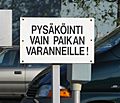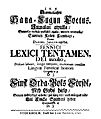Finnish language facts for kids
Quick facts for kids Finnish |
||||
|---|---|---|---|---|
| Suomen kieli | ||||
| Native to | Finland, Estonia, Ingria, Karelia, Norway, Sweden | |||
| Native speakers | c. 5 million (2011) | |||
| Language family |
Uralic
|
|||
| Writing system | Latin (Finnish alphabet) Finnish Braille |
|||
| Official status | ||||
| Official language in | recognised as minority language in:
|
|||
| Regulated by | Language Planning Department of the Institute for the Languages of Finland | |||

Official language. Spoken by a minority.
|
||||
|
||||
Finnish (called Finnish: Suomen kieli in Finnish) is a unique language from the Uralic language family. It's one of the two official languages in Finland. It's also recognized as an official minority language in Sweden.
Did you know Finnish is one of only four national languages in Europe that isn't an Indo-European language? The others are Estonian, Hungarian (also Uralic languages), and Basque. About 5 million people speak Finnish.
Contents
How Finnish Connects to Other Languages
Finnish grammar and most Finnish words are very different from those in other European languages. This is because Finnish is not an Indo-European language.
The two other national languages that are Uralic languages, like Finnish, are Estonian and Hungarian. People who speak Estonian and Finnish can often understand each other a little. However, their languages are still quite different.
Even though Finnish and Hungarian are related, they don't sound or look similar at all. These languages separated a very long time ago. Each language then developed its own unique vocabulary. This means a Finnish speaker cannot understand Hungarian without studying it. The same goes for Hungarians trying to understand Finnish.
But there are a few basic words that are very similar! For example:
- 'hand' is käsi in Finnish and kéz in Hungarian.
- 'to go' is mennä in Finnish and menni in Hungarian.
- 'fish' is kala in Finnish and hal in Hungarian.
Understanding Finnish Grammar
Finnish is a synthetic and agglutinative language. This means that words in Finnish are built by adding many small parts to a main word stem. Each added part changes the word's meaning.
Think of it like building with LEGOs. You start with a base brick (the stem). Then you add other special bricks (endings) to change what the word does in a sentence. This is similar to how Japanese, Turkish, and Latin languages work.
In Finnish, there are 17 different word types, called cases. A "case" is an ending added to a word. It helps show the word's role in a sentence. For example, it shows if a word is the subject, object, or location.
Finnish verbs also have 5 tempora (which means tenses). These include the present tense, past tense, perfect, pluperfect, and future tense. Verbs also have two participle forms (active and passive).
Gerunds are also common in Finnish. A gerund is a noun made from a verb. For example, "reading" (lukeminen) comes from "to read" (lukea).
Finnish is known for being a complex language. The U.S. Department of State has even ranked it as very difficult for native English speakers to learn. This difficulty comes from its unique grammar structure. It also comes from its pronunciation and how you use your voice (intonation), which are different from English.
Finnish Spelling and Pronunciation
One cool thing about Finnish is that it's pronounced exactly how it's spelled! This means if you know the rules, you can usually say any Finnish word correctly just by reading it.
Some letters sound like English, but others are different:
- j sounds like the 'y' in 'yes'.
- s sounds like the 's' in 'sad' (never like 'z').
- h is always pronounced, even at the end of a syllable. For example, in 'ahdas' (meaning 'narrow').
- When you see a double vowel (like 'aa' or 'uu'), it means you make the sound long.
- ä sounds similar to the 'a' in English 'cat'.
- ö is almost like the English word 'a', but with rounded lips. It's like the 'eu' in French 'peur'.
- The letter c is not used. It's replaced by 'k' or 's' to keep writing simple.
- The letter q is not used. It's replaced by 'k' or 'kv' for simplicity.
- The letter y sounds like the 'u' in French, or the 'i' in 'in' but with rounded lips. It's very close to 'ö'.
- The letter z sounds like 'ts', similar to German. It's often written as "ts" to make writing simple.
- The letter x is usually written as 'ks' to make writing simple. For example, "taksi" instead of "taxi".
English speakers often exhale a puff of air when saying letters like "k", "p", and "t". In Finnish, you don't do this. Learning to "swallow the sound" takes a lot of practice!
The proper pronunciation for Finnish diphthongs (like öy, yö, äy, eu) can also be tricky.
Common Finnish Words
| Yksi | One |
| Kaksi | Two |
| Kolme | Three |
| Kyllä | Yes |
| Ei | No |
| Minä | I |
| Sinä/Te | You |
| Hän | He/She |
| Me | We |
| He | They |
| Olen/Minä olen | I am |
| Suomi | Finland |
| Talo | House |
| Koti | Home |
| Tie | Way |
| Äiti | Mother |
| Isä | Father |
| Tyttö | Girl |
| Poika | Boy |
| Vauva | Baby |
| Auto | Car |
| Juna | Train |
| Lentokone | Airplane |
| Ravintola | Restaurant |
| Nukke | Doll |
| Sänky | Bed |
| Tuoli | Chair |
| Kaupunki | City/Town |
| Puisto | Park |
| Polkupyörä | Bicycle |
| Kukka | Flower |
| Kevät | Spring |
| Kesä | Summer |
| Syksy | Autumn/Fall |
| Talvi | Winter |
Basic Finnish Phrases
| Terve | Hello |
| Mitä kuuluu? | How are you? (informal) |
| Kiitos hyvää | Very well, thank you |
| Kiitos | Thank you |
| Kiitos paljon | Thank you very much |
| Hyvää huomenta | Good morning |
| Hyvää iltaa | Good evening |
| Hyvää yötä | Good night |
| Hyvästi | Goodbye |
| Nimeni on Anna | My name is Anna |
| En osaa puhua suomea | I can't speak Finnish |
| It's cold today | |
| Puhutteko englantia? | Do you speak English? |
Images for kids
-
Mikael Agricola, a 19th-century drawing by Albert Edelfelt. He is often called the "father of written Finnish".
-
Elias Lönnrot as depicted in a 19th-century drawing. Lönnrot traveled to Karelia and Eastern Finland to collect old stories and songs. He then put them together to create the Kalevala, Finland's national epic.
-
The Turku dialect is famous for its seemingly inverted questions. For example, "Ei me mittä kaffelle men?" looks like it means "So we don't go for a coffee?" but actually means "Shall we go for a coffee?"
See also
 In Spanish: Idioma finés para niños
In Spanish: Idioma finés para niños









